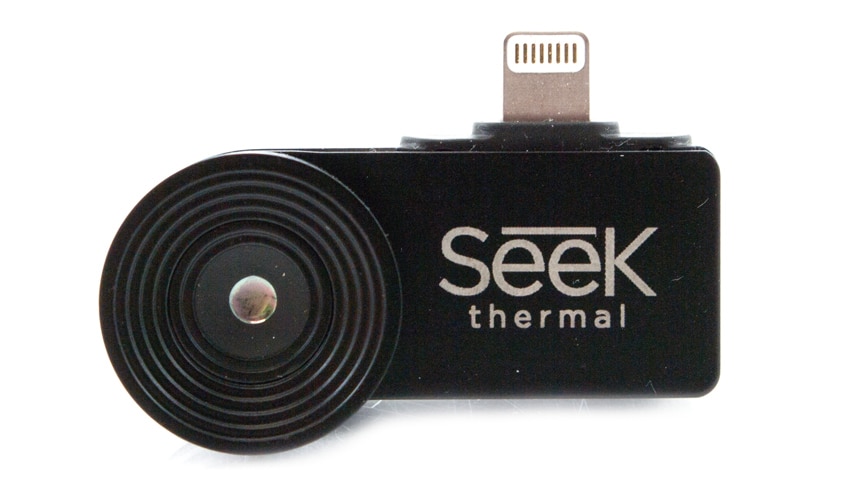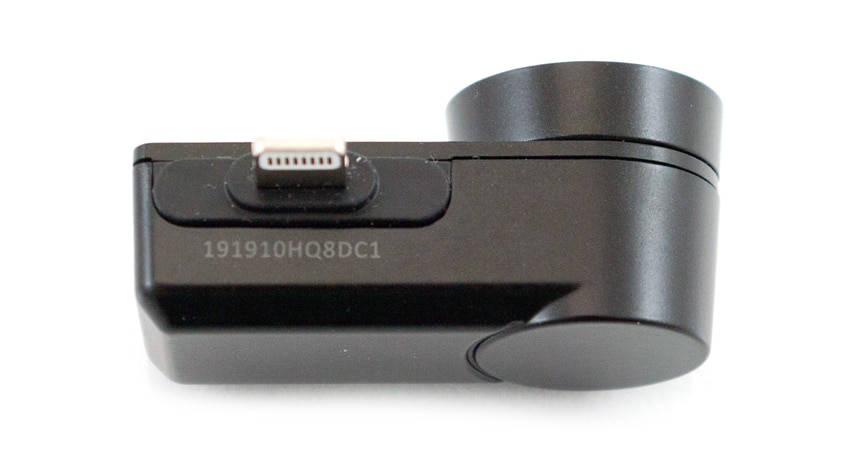
The Seek thermal camera is an ultra-portable thermal imaging camera attached to, and managed by, newer generation Android and iOS mobile devices and is an ideal alternative for consumers or small-to-medium sized businesses that do not want to spend thousands of dollars on professional cameras. Working in both complete darkness and daylight, the Seek thermal detects the infrared light that is emitted by objects and uses the collected data from over 32,000 thermal pixels to create a visible image on the smartphone. The thermal sensor of the Seek has a resolution of 206 x 156 pixels and features a 36° field of view, which is more than enough for our use cases. It also comes in an XR model, which stands for “Xtra Range”, allowing users to see objects at greater distances with adjustable focus and a narrower 20° field of focus.

Consumer-grade thermal cameras are often used to detect things like poor insulation and other energy inefficiencies such as locating water leaks. Thermal cameras are also very useful for detecting a gradient of heat/coolness in a given area, which makes highlighting issues much easier. In our case we will be using the Seek thermal camera in the StorageReview Lab to see what’s currently active, as well as where occurring and potential hot spots are located. Detecting poor ventilation in or around hardware is important to many businesses, especially for those that rely on enterprise server and storage equipment.

Thermal camera technology also offers various benefits over IR Thermometers, which is the other main measurement tool for displaying temperature levels. For example, they are able to detect temperatures from multiple points at the same time all the while transferring this data into a thermal image quicker. IR thermometers, on the other hand, are only able to measure one single spot at a time. Thermal camera imagery also adapts better to changes in environment temperature in addition to being more sensitive to these changes.
The Seek thermal camera goes for roughly $250 at third-party online retailers. We will be looking at the iOS version for this review.
Seek thermal camera Specifications and Features:
- iOS Lightening Thermal Camera: Model LW-AAA
- Works on iOS devices running iOS 7+
- True Thermal Sensor
- 206 x 156 Array
- 12μ Pixel Pitch
- Vanadium Oxide Microbolometer
- Chalcogenide Lens
- 36° Field of View
- Magnesium Housing
- Long Wave Infrared 7.2 – 13 Microns
- -40C to 330C Detection
- < 9Hz
- Includes Protective Carrying Case
Design and build
The Seek thermal camera sports a very compact body, measuring just two inches in width. This allows users to stash the camera away in their pocket or bag, allowing for more frequent use since it is so portable. The build of the camera is comprised of a no frills, plastic design, with the Seek thermal branding located right of the lens. It also comes packaged with a carrying case with a rubber-lined interior for protection when being stored between uses.
The design of the camera and positioning of the Lightning connector allow the device to be attached and not add to the total width of the iPhone 6 while carrying it. This is true for both orientations that the camera is plugged in (as the Lightning connector is reverisble). One downside when it comes to clipping into place though is the plug is slightly too short to be connected with some protective cases around your iPhone.
Lab Usage and Image Quality
The Seek thermal camera is managed through the Seek thermal App, offering simple navigation and responsive controls. The app allows for both still image and video capture, multiple color palette options to visualize thermal conditions, and even different thermal modes to best fit the situation. In our uses, we’ve leveraged the traditional white-hot and block-hot color palettes, as well as “Iron” in some cases to highlight temperature differences. Another incredibly useful feature is the Thermal Mode section, where you can switch the camera between multiple imaging modes:
- Normal: Traditional thermal imaging without temperature values overlaid
- Spot: Thermal imaging with a center temperature measurement
- High/Low (our favorite): Thermal imaging with constantly updating low/hot points marked with their respective measurements.
- Threshold: Highlight temperature zones above, equal to, or below the temperature chosen.
As indicated the High/Low option is one or our favorites to use around the lab. With the thermal gradient plotted around devices, we are able to quickly tell what the hottest point is in the zone we are viewing, as well as the lowest. This is helpful when monitoring cooling and airflow through devices, as well as locating cooling obstructions that might be causing localized hotspots. Another use case for this feature is that it allows you to move through a test lab and pick out equipment that may have been accidentally left powered on to minimize power usage. Below are a number of thermal photos taken from around our office:
HVAC cooling vents behind our server racks
HVAC return air ducts from the datacenter (visible through the wall)
Exterior HVAC condenser unit
Front of the server racks, showing hot zones from switches with side-to-side cooling fans that leave some hot air in the top of the rack
Front of a 1GbE switch (top) and 16Gb FC switch (below). The hot-spots on the FC switch are the optical transceivers that are plugged in and active.
Rear of a storage array with the cooling exhaust fans pushing out hot air.
Server power supply cooling fans
Three-phase UPS rear photo, showing minimal fan heat output during standby activity. No localized hot-spots around input or output power connections
Conclusion
Available in both iPhone and Android versions, the Seek thermal camera certainly does what it is intended to do, offering users with an inexpensive alternative to professional-grade thermal cameras. For our purposes at StorageReview, the Seek thermal camera did a great job of spotting thermal activity in our lab, both hot spots and cold spots from cooling. The included app was simple to use and offers a variety of useful options. While the camera offers a resolution of 206 x 156 pixels, the images and videos the Seek won’t be as clear as the standard camera in your smartphone, but are still detailed enough to identify objects well. That being said, superior image quality isn’t an important feature in most scenarios including our own; many users just want to find the areas of interests, not fine details of the object itself. For macro or distance shots, the XR model offers some advantages with its adjustable focus and tighter field of focus.
As far as pricing goes, its $250 price tag is only fraction of what professional thermal cameras are going for with a similar resolution. Its lower entry price lets companies test the waters with thermal imaging or get it into the hands of more employees. Overall we found it quite useful in our own lab, where different cooling methods are being experimented equipment temperature metrics need to be monitored with more gradient than a spot IR-meter.
Pros
- Useful thermal resolution with broad temperature range supported
- Easy-to-use software with handy features
- Very inexpensive compared to professional-grade alternatives
Cons
- Doesn’t connect well through some phone cases
Bottom Line
The Seek thermal camera is an innovative and cost effective solution, offering businesses a compelling alternative to professional-grade thermal imagers.
Sign up for the StorageReview newsletter











